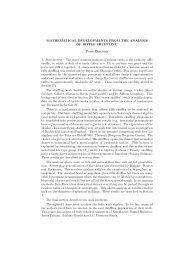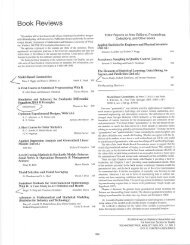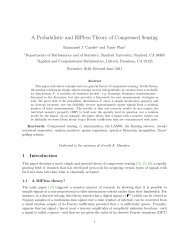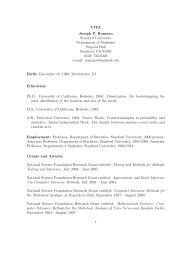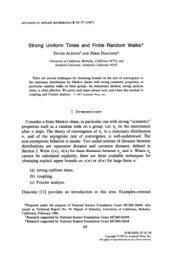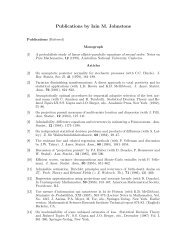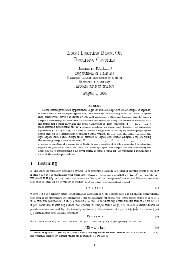A robust hybrid of lasso and ridge regression - Stanford University
A robust hybrid of lasso and ridge regression - Stanford University
A robust hybrid of lasso and ridge regression - Stanford University
You also want an ePaper? Increase the reach of your titles
YUMPU automatically turns print PDFs into web optimized ePapers that Google loves.
A <strong>robust</strong> <strong>hybrid</strong> <strong>of</strong> <strong>lasso</strong> <strong>and</strong> <strong>ridge</strong> <strong>regression</strong><br />
Art B. Owen<br />
<strong>Stanford</strong> <strong>University</strong><br />
October 2006<br />
Abstract<br />
Ridge <strong>regression</strong> <strong>and</strong> the <strong>lasso</strong> are regularized versions <strong>of</strong> least squares<br />
<strong>regression</strong> using L2 <strong>and</strong> L1 penalties respectively, on the coefficient vector.<br />
To make these <strong>regression</strong>s more <strong>robust</strong> we may replace least squares with<br />
Huber’s criterion which is a <strong>hybrid</strong> <strong>of</strong> squared error (for relatively small<br />
errors) <strong>and</strong> absolute error (for relatively large ones). A reversed version<br />
<strong>of</strong> Huber’s criterion can be used as a <strong>hybrid</strong> penalty function. Relatively<br />
small coefficients contribute their L1 norm to this penalty while larger<br />
ones cause it to grow quadratically. This <strong>hybrid</strong> sets some coefficients<br />
to 0 (as <strong>lasso</strong> does) while shrinking the larger coefficients the way <strong>ridge</strong><br />
<strong>regression</strong> does. Both the Huber <strong>and</strong> reversed Huber penalty functions<br />
employ a scale parameter. We provide an objective function that is jointly<br />
convex in the <strong>regression</strong> coefficient vector <strong>and</strong> these two scale parameters.<br />
1 Introduction<br />
We consider here the <strong>regression</strong> problem <strong>of</strong> predicting y ∈ R based on z ∈ R d .<br />
The training data are pairs (zi, yi) for i = 1, . . . , n. We suppose that each vector<br />
<strong>of</strong> predictor vectors zi gets turned into a feature vector xi ∈ R p via zi = φ(xi)<br />
for some fixed function φ. The predictor for y is linear in the features, taking<br />
the form µ + x ′ β where β ∈ R p .<br />
In <strong>ridge</strong> <strong>regression</strong> (Hoerl <strong>and</strong> Kennard, 1970) we minimize over β, a criterion<br />
<strong>of</strong> the form<br />
n<br />
i=1<br />
(yi − µ − x ′ iβ) 2 + λ<br />
p<br />
j=1<br />
β 2 j , (1)<br />
for a <strong>ridge</strong> parameter λ ∈ [0, ∞]. As λ ranges through [0, ∞] the solution β(λ)<br />
traces out a path in R p . Adding the penalty reduces the variance <strong>of</strong> the estimate<br />
β(λ) while introducing a bias. The intercept µ does not appear in the quadratic<br />
penalty term.<br />
Defining εi = yi − µ − x ′ i β, <strong>ridge</strong> <strong>regression</strong> minimizes ε2 2 + λβ 2 2. Ridge<br />
<strong>regression</strong> can also be described via penalization. If we were to minimize ε2<br />
1
subject to an upper bound constraint on β2 we would get the same path,<br />
though each point on it might correspond to a different λ value.<br />
The Lasso (Tibshirani, 1996) modifies the criterion (1) to<br />
n<br />
i=1<br />
(yi − µ − x ′ iβ) 2 + λ<br />
p<br />
|βj|. (2)<br />
The <strong>lasso</strong> replaces the L2 penalty β 2 2 by an L1 penalty β1. The main benefit<br />
<strong>of</strong> the <strong>lasso</strong> is that it can find sparse solutions, ones in which some or even most<br />
<strong>of</strong> the βj are zero. Sparsity is desirable for interpretation.<br />
One limitation <strong>of</strong> the <strong>lasso</strong> is that it has some amount <strong>of</strong> sparsity forced onto<br />
it. There can be at most p nonzero βjs. This can only matter when p > n but<br />
such problems do arise. There is also folklore to suggest that sparsity from an<br />
L1 penalty may come at the cost <strong>of</strong> less accuracy than would be attained by an<br />
L2 penalty. When there are several correlated features with large effects on the<br />
response, the <strong>lasso</strong> has a tendency to zero out some <strong>of</strong> them, perhaps all but<br />
one <strong>of</strong> them. Ridge <strong>regression</strong> does not make such a selection but tends instead<br />
to ‘share’ the coefficient value among the group <strong>of</strong> correlated predictors.<br />
The sparsity limitation can be removed in several ways. The elastic net <strong>of</strong><br />
Zou <strong>and</strong> Hastie (2005) applies a penalty <strong>of</strong> the form λ1β1 + λ2β 2 2. The<br />
method <strong>of</strong> composite absolute penalties (Zhao et al., 2005) generalizes this<br />
penalty to<br />
j=1<br />
<br />
<br />
<br />
γ0<br />
βG1γ1 , βG2γ2 , . . . βGkγk . (3)<br />
Each Gj is a subset <strong>of</strong> {1, . . . , p} <strong>and</strong> then βGj is the vector made by extracting<br />
from β the components named in Gj. The penalty is thus a norm on a vector<br />
whose components are themselves penalties. In practice the Gj are chosen based<br />
on the structure <strong>of</strong> the <strong>regression</strong> features.<br />
The goal <strong>of</strong> this paper is to do some carpentry. We develop a criterion <strong>of</strong><br />
the form<br />
n<br />
L(yi − µ − x ′ p<br />
iβ) + λ P (βj) (4)<br />
i=1<br />
for convex loss <strong>and</strong> penalty functions L <strong>and</strong> P respectively. The penalty function<br />
is chosen to behave like the absolute value function at small βj in order to make<br />
sparse solutions possible, while behaving like squared error on large βj to capture<br />
the coefficient sharing property <strong>of</strong> <strong>ridge</strong> <strong>regression</strong>.<br />
The penalty function is essentially a reverse <strong>of</strong> a famous loss function due<br />
to Huber. Huber’s loss function treats small errors quadratically to gain high<br />
efficiency, while counting large ones by their absolute error for <strong>robust</strong>ness.<br />
Section 2 recalls Huber’s loss function for <strong>regression</strong>, that treats small errors<br />
like they were Gaussian while treating large errors as if they were from a heavier<br />
tailed distribution. Section 3 presents the reversed Huber penalty function.<br />
This treats small coefficient values like the <strong>lasso</strong>, but treats large ones like <strong>ridge</strong><br />
2<br />
j=1
egression. Both the loss <strong>and</strong> penalty function require concomitant scale estimation.<br />
Section 4 describes a technique, due to Huber (1981) for constructing<br />
a function that is jointly convex in both the scale parameters <strong>and</strong> the original<br />
parameters. Huber’s device is called the perspective transformation in convex<br />
analysis. See Boyd <strong>and</strong> V<strong>and</strong>enberghe (2004). Some theory for the perspective<br />
transformation as applied to penalized <strong>regression</strong> is given in Section (5). Section<br />
6 shows how to optimize the convex penalized <strong>regression</strong> criterion using the<br />
cvx Matlab package <strong>of</strong> Grant et al. (2006). Some special care must be taken to<br />
fit the concomitant scale parameters into the criterion. Section (7) illustrates<br />
the method on the diabetes data. Section (8) gives conclusions.<br />
2 Huber function<br />
The least squares criterion is well suited to yi with a Gaussian distribution but<br />
can give poor performance when yi has a heavier tailed distribution or what<br />
is almost the same, when there are outliers. Huber (1981) describes a <strong>robust</strong><br />
estimator employing a loss function that is less affected by very large residual<br />
values. The function<br />
<br />
z<br />
H(z) =<br />
2 2|z| − 1<br />
|z| ≤ 1<br />
|z| ≥ 1<br />
is quadratic in small values <strong>of</strong> z but grows linearly for large values <strong>of</strong> z. The<br />
Huber criterion can be written as<br />
n <br />
yi − µ − x<br />
HM<br />
′ iβ <br />
(5)<br />
σ<br />
where<br />
i=1<br />
HM (z) = M 2 H(z/M) =<br />
<br />
z 2 |z| ≤ M<br />
2M|z| − M 2 |z| ≥ M.<br />
The parameter M describes where the transition from quadratic to linear takes<br />
place <strong>and</strong> σ > 0 is a scale parameter for the distribution. Errors smaller than<br />
Mσ get squared while larger errors increase the criterion only linearly.<br />
The quantity M is a shape parameter that one chooses to control the amount<br />
<strong>of</strong> <strong>robust</strong>ness. At larger values <strong>of</strong> M, the Huber criterion becomes more similar<br />
to least squares <strong>regression</strong> making ˆ β more efficient for normally distributed<br />
data but less <strong>robust</strong>. For small values <strong>of</strong> M, the criterion is more similar to L1<br />
<strong>regression</strong>, making it more <strong>robust</strong> against outliers but less efficient for normally<br />
distributed data. Typically M is held fixed at some value, instead <strong>of</strong> estimating<br />
it from data. Huber proposes M = 1.35 to get as much <strong>robust</strong>ness as possible<br />
while retaining 95% statistical efficiency for normally distributed data.<br />
For fixed values <strong>of</strong> M <strong>and</strong> σ <strong>and</strong> a convex penalty P (·), the function<br />
n<br />
i=1<br />
HM<br />
yi − µ − x ′ i β<br />
σ<br />
3<br />
<br />
+ λ<br />
p<br />
P (βj) (6)<br />
j=1
is convex in (µ, β) ∈ R p+1 . We treat the important problem <strong>of</strong> choosing the<br />
scale parameter σ in Section 4.<br />
3 Reversed Huber function<br />
Huber’s function is quadratic near zero but linear for large values. It is well<br />
suited to errors that are nearly normally distributed with somewhat heavier<br />
tails. It is not well suited as a regularization term on the <strong>regression</strong> coefficients.<br />
The classical <strong>ridge</strong> <strong>regression</strong> uses an L2 penalty on the <strong>regression</strong> coefficients.<br />
An L1 regularization function is <strong>of</strong>ten preferred. It commonly produces<br />
a vector β ∈ R p with some coefficients βj exactly equal to 0. Such a sparse<br />
model may lead to savings in computation <strong>and</strong> storage. The results are also<br />
interpretable in terms <strong>of</strong> model selection <strong>and</strong> Donoho <strong>and</strong> Elad (2003) have<br />
described conditions under which L1 regularization obtains the same solution<br />
as model selection penalties proportional to the number <strong>of</strong> nonzero βj, <strong>of</strong>ten<br />
referred to as an L0 penalty.<br />
A disadvantage <strong>of</strong> L1 penalization is that it can not produce more than n<br />
nonzero coefficients even though settings with p > n are among the prime motivators<br />
<strong>of</strong> regularized <strong>regression</strong>. It is also sometimes thought to be less accurate<br />
in prediction than L2 penalization. We propose here a <strong>hybrid</strong> <strong>of</strong> these penalties<br />
that is the reverse <strong>of</strong> Huber’s function: L1 for small values, quadratically<br />
extended to large values. This ‘Berhu’ function is<br />
B(z) =<br />
<strong>and</strong> for M > 0, a version <strong>of</strong> it is<br />
BM (z) = MBM<br />
<br />
|z| |z| ≤ 1<br />
z 2 +1<br />
2<br />
|z| ≥ 1,<br />
<br />
<br />
z<br />
<br />
|z| |z| ≤ M<br />
=<br />
M<br />
|z| ≥ M.<br />
z 2 +M 2<br />
2M<br />
The function BM (z) is convex in z. The scalar M describes where the transition<br />
from a linearly shaped to a quadratically shaped penalty takes place.<br />
Figure 1 depicts both BM <strong>and</strong> HM . Figure 2 compares contours <strong>of</strong> the Huber<br />
<strong>and</strong> Berhu functions in R2 with contours <strong>of</strong> L1 <strong>and</strong> L2 penalties. Those penalty<br />
functions whose contours are ’pointy’ where some β values vanish make sparse<br />
solutions have positive probability.<br />
The Berhu function also needs to be scaled. Letting τ > 0 be the scale<br />
parameter we may replace (6) with<br />
n<br />
i=1<br />
HM<br />
yi − µ − x ′ i β<br />
σ<br />
<br />
+ λ<br />
p<br />
j=1<br />
BM<br />
<br />
βj<br />
. (7)<br />
τ<br />
Equation (7) is jointly convex in µ <strong>and</strong> β given M, τ, <strong>and</strong> σ. Note that we<br />
could in principal use different values <strong>of</strong> M in H <strong>and</strong> B.<br />
Our main goal is to develop BM as a penalty function. Such a penalty can<br />
be employed with HM or with squared error loss on the residuals,<br />
4
Figure 1: On the left is the Huber function drawn as a thick curve with a thin<br />
quadratic function. On the right is the Berhu function drawn as a thick curve<br />
with a thin absolute value function.<br />
4 Concomitant scale estimation<br />
The parameter M can be set to some fixed value like 1.35. But there remain 3<br />
tuning parameters to consider, λ, σ, <strong>and</strong> τ. Instead <strong>of</strong> doing a 3 dimensional<br />
parameter search, we derive instead a natural criterion that is jointly convex in<br />
(µ, β, σ, τ), leaving only a one dimensional search over λ.<br />
The method for h<strong>and</strong>ling σ <strong>and</strong> τ is based on a concomitant scale estimation<br />
method from <strong>robust</strong> <strong>regression</strong>. First we recall the issues in choosing σ. The<br />
solution also applies to the less familiar parameter τ.<br />
If one simply fixed σ = 1 then the effect <strong>of</strong> a multiplicative rescaling <strong>of</strong> yi<br />
(such as changing units) would be equivalent to an inverse rescaling <strong>of</strong> M. In<br />
extreme cases this scaling would cause the Huber estimator to behave like least<br />
squares or like L1 <strong>regression</strong> instead <strong>of</strong> the desired <strong>hybrid</strong> <strong>of</strong> the two. The value<br />
<strong>of</strong> σ to be used should scale with yi; that is if each yi is replaced by cyi for<br />
c > 0 then an estimate ˆσ should be replaced by cˆσ. In practice it is necessary<br />
to estimate σ from the data, simultaneously with β. Of course the estimate ˆσ<br />
should also be <strong>robust</strong>.<br />
Huber proposed several ways to jointly estimate σ <strong>and</strong> β. One <strong>of</strong> his ideas<br />
5
Figure 2: This figure shows contours <strong>of</strong> four penalty/loss functions for a bivariate<br />
argument β = (β1, β2). The upper left shows contours <strong>of</strong> the L2 penalty β2.<br />
The lower right has contours <strong>of</strong> the L1 penalty. The upper right has contours<br />
<strong>of</strong> H(β1) + H(β2). <strong>and</strong> the lower left has contours <strong>of</strong> B(β1) + B(β2). Small<br />
values <strong>of</strong> β contribute quadratically to the functions depicted in the top row<br />
<strong>and</strong> via absolute value to the functions in the bottom row. Large values <strong>of</strong> β<br />
contribute quadratically to the functions in the left column <strong>and</strong> via absolute<br />
value to functions in the right column.<br />
for <strong>robust</strong> <strong>regression</strong> is to minimize<br />
nσ +<br />
n<br />
i=1<br />
HM<br />
yi − µ − x ′ i β<br />
σ<br />
<br />
σ (8)<br />
over β <strong>and</strong> σ. For any fixed value <strong>of</strong> σ ∈ (0, ∞), the minimizer β <strong>of</strong> (8) is the<br />
same as that <strong>of</strong> (5). The criterion (8) however is jointly convex as a function<br />
6
<strong>of</strong> (β, σ) ∈ Rp × (0, ∞), as shown in Section 5. Therefore convex optimization<br />
can be applied to estimate β <strong>and</strong> σ together. This removes the need for ad hoc<br />
algorithms that alternate between estimating β for fixed σ <strong>and</strong> σ for fixed β.<br />
We show below that the criterion in equation (8) is only useful for M > 1 (the<br />
usual case) but an easy fix is available if it is desired to use M ≤ 1.<br />
The same idea can be used for τ. The function τ + BM (β/τ)τ is jointly<br />
convex in β <strong>and</strong> τ. Using Huber’s penalty function on the <strong>regression</strong> errors <strong>and</strong><br />
the Berhu function on the coefficients leads to a criterion <strong>of</strong> the form<br />
nσ +<br />
n<br />
i=1<br />
HM<br />
yi − µ − x ′ i β<br />
σ<br />
<br />
σ + λ pτ +<br />
p<br />
j=1<br />
BM<br />
<br />
βj<br />
τ<br />
τ<br />
where λ ∈ [0, ∞] governs the amount <strong>of</strong> regularization applied. There are now<br />
two transition parameters to select, Mr for the residuals <strong>and</strong> Mc for the coefficients.<br />
The expression in (9) is jointly convex in (µ, β, σ, τ) ∈ R p+1 × (0, ∞) 2 ,<br />
provided that the value M in HM is larger than 1. See Section 5.<br />
Once again we can <strong>of</strong> course replace HM by the square <strong>of</strong> it’s argument<br />
if we don’t need <strong>robust</strong>ness. Just as the loss function HM corresponds to a<br />
likelihood in which errors are Gaussian at small values but have relatively heavy<br />
exponential tails, the function BM corresponds to a prior distribution on β with<br />
Gaussian tails <strong>and</strong> a cusp at 0.<br />
5 Theory for concomitant scale estimation<br />
Huber (1981, page 179) presents a generic method <strong>of</strong> producing joint locationscale<br />
estimates from a convex criterion. Lemmas 1 <strong>and</strong> 2 reproduce Huber’s<br />
results, with a few more details than he gave. We work with the loss term<br />
because it is more familiar, but similar conclusions happen for the penalty term.<br />
Lemma 1 Let ρ be a convex <strong>and</strong> twice differentiable function on an interval<br />
I ⊆ R. Then ρ(η/σ)σ is a convex function <strong>of</strong> (η, σ) ∈ I × (0, ∞).<br />
Pro<strong>of</strong>: Let η0 ∈ I <strong>and</strong> σ0 ∈ (0, ∞) <strong>and</strong> then parameterize η <strong>and</strong> σ linearly as<br />
η = η0 + c × t <strong>and</strong> σ = σ0 + s × t over t in an open interval containing 0. The<br />
symbols c <strong>and</strong> s are mnemonic for cos(θ) <strong>and</strong> sin(θ) where θ ∈ [0, 2π) denotes a<br />
direction. We will show that the curvature <strong>of</strong> ρ(η/σ)σ is nonnegative in every<br />
direction.<br />
The derivative <strong>of</strong> η/σ with respect to t is (cσ − sη)/σ 2 <strong>and</strong> so<br />
d<br />
dt ρ<br />
<br />
η<br />
σ<br />
<br />
σ = ρ ′ η<br />
<br />
cσ − sη<br />
<br />
η<br />
<br />
+ ρ s,<br />
σ σ σ<br />
<strong>and</strong> then after some cancellations<br />
d2 <br />
η<br />
<br />
ρ σ = ρ<br />
dt2 σ<br />
′′ η<br />
2 (cσ − sη)<br />
σ σ3 ≥ 0. <br />
7<br />
(9)
Lemma 2 Let ρ be a convex function on an interval I ⊆ R. Then ρ(η/σ)σ is<br />
a convex function <strong>of</strong> (η, σ) ∈ I × (0, ∞).<br />
Pro<strong>of</strong>: Fix two points (η0, σ0) <strong>and</strong> (η1, σ1) both in I × (0, ∞). Let η =<br />
λη1 + (1 − λ)η0 <strong>and</strong> σ = λσ1 + (1 − λ)σ0 for 0 < λ < 1. For ɛ > 0, let ρɛ be a<br />
convex <strong>and</strong> twice differentiable function on I that is everywhere within ɛ <strong>of</strong> ρ.<br />
Then<br />
<br />
η<br />
<br />
η<br />
<br />
ρ σ ≥ ρɛ σ − ɛσ ≥ λρɛ<br />
σ σ<br />
<br />
η1<br />
≥ λρ σ1 + (1 − λ)ρ<br />
σ1<br />
η1<br />
σ1<br />
<br />
η0<br />
Taking ɛ arbitrarily small we find that<br />
<br />
η<br />
<br />
η1<br />
ρ σ ≥ λρ σ1 + (1 − λ)ρ<br />
σ<br />
σ1<br />
<br />
<br />
η0<br />
σ1 + (1 − λ)ρɛ σ0 − ɛσ<br />
σ0<br />
<br />
<br />
σ0 + ɛ λσ1 + (1 − λ)σ0 − σ .<br />
σ0<br />
η0<br />
<strong>and</strong> so ρ(η/σ)/σ is convex for (η, σ) ∈ I × (0, ∞). <br />
Theorem 1 Let yi ∈ R <strong>and</strong> xi ∈ Rp for i = 1, . . . , n. Let ρ be a convex function<br />
on R. Then<br />
n <br />
yi − µ − x<br />
nσ + ρ<br />
′ iβ <br />
σ<br />
σ<br />
i=1<br />
is convex in (µ, β, σ) ∈ R p+1 × (0, ∞).<br />
Pro<strong>of</strong>: The first term nσ is linear <strong>and</strong> so we only need to show that the second<br />
term is convex. The function ψ(η, τ) = ρ(η/τ)τ is convex in (η, τ) ∈ R × (0, ∞)<br />
by Lemma 2. The mapping under which (η, τ) → (yi−µ−x ′ iβ, σ) is affine <strong>and</strong> so<br />
η(yi − x ′ iβ, σ) is convex for (β, σ) in the affine preimage <strong>of</strong> (α, τ) ∈ R × (0, ∞).<br />
Thus ρ((yi − x ′ iβ)/σ)σ is convex over (β, σ) ∈ Rp × (0, ∞). The sum over i<br />
preserves convexity. <br />
It is interesting to look at Huber’s proposal as applied to L1 <strong>and</strong> L2 <strong>regression</strong>.<br />
Taking ρ(z) = z 2 in Lemma 1 we obtain the well known result that β 2 /σ<br />
is convex on (β, σ) ∈ (−∞, ∞) × (0, ∞). Theorem 1 shows that<br />
nσ +<br />
n<br />
i=1<br />
(yi − µ − x ′ i β)2<br />
σ<br />
σ0<br />
<br />
σ0<br />
(10)<br />
is convex in (µ, β, σ) ∈ R p × (0, ∞). The function (10) is minimized by taking<br />
µ <strong>and</strong> β to be their least squares estimates <strong>and</strong> σ = ˆσ where<br />
ˆσ 2 = 1<br />
n<br />
n<br />
i=1<br />
(yi − ˆµ − x ′ i ˆ β) 2 . (11)<br />
8
Thus minimizing (10) gives rise to the usual normal distribution maximum<br />
likelihood estimates. This is interesting because equation (10) is not a simple<br />
monotone transformation <strong>of</strong> the negative log likelihood<br />
n<br />
1<br />
log(2π) + n log σ +<br />
2 2σ2 n<br />
i=1<br />
(yi − µ − x ′ iβ) 2 . (12)<br />
The negative log likelihood (12) fails to be convex in σ (for any fixed µ, β) <strong>and</strong><br />
hence cannot be jointly convex. Huber’s technique has convexified the Gaussian<br />
log likelihood (12) into equation (10).<br />
Turning to the least squares case, we can substitute (11) into the criterion<br />
<strong>and</strong> obtain 2( n i=1 (yi − µ − x ′ iβ)2 ) 1/2 . A <strong>ridge</strong> <strong>regression</strong> incorporating scale<br />
factors for both the residuals <strong>and</strong> coefficients then minimizes<br />
p <br />
R(µ, β, τ, σ; λ) = nσ +<br />
n<br />
i=1<br />
(yi − µ − x ′ i β)2<br />
σ<br />
+ λ<br />
pτ +<br />
over (µ, β, σ, τ) ∈ R p+1 × [0, ∞] 2 for fixed λ ∈ [0, ∞]. The minimization over σ<br />
<strong>and</strong> τ may be done in closed form, leaving<br />
<br />
n<br />
min R(β, τ, σ; λ) = 2<br />
τ,σ<br />
i=1<br />
(yi − µ − x ′ iβ) 2<br />
1/2<br />
+ 2λ<br />
p<br />
j=1<br />
j=1<br />
β 2 j<br />
β 2 j<br />
τ<br />
1/2<br />
(13)<br />
to be minimized over β given λ. In other words, after putting Huber’s concomitant<br />
scale estimators into <strong>ridge</strong> <strong>regression</strong> we recover <strong>ridge</strong> <strong>regression</strong> again. The<br />
criterion is y −µ−x ′ β2 +λβ2 which gives the same trace as y −µ−x ′ β 2 2 +<br />
λβ 2 2.<br />
Taking ρ(z) = |z| we obtain a degenerate result: σ + ρ(β/σ)σ = σ + |β|.<br />
Although this function is indeed convex for (β, σ) ∈ R × (0, ∞) it is minimized<br />
as σ ↓ 0 without regard to β. Thus Huber’s device does not yield a usable<br />
concomitant scale estimate for an L1 <strong>regression</strong>.<br />
The degeneracy for L1 loss propagates to the Huber loss HM when M ≤ 1.<br />
We may write<br />
σ + HM (z/σ)σ =<br />
<br />
σ + z 2 /σ σ ≥ |z|/M<br />
σ + 2M|z| − M 2 σ σ ≤ |z|/M.<br />
(14)<br />
The minimum <strong>of</strong> (14) over σ ∈ [0, ∞] is attained at σ = 0 regardless <strong>of</strong> z. For<br />
z = 0, the derivative <strong>of</strong> (14) with respect to σ is 1 − M 2 ≤ 0 on the second<br />
branch <strong>and</strong> 1 − z 2 /σ 2 ≤ 1 − z 2 /(|z|/M) 2 ≤ 0 on the first. The z = 0 case is<br />
simpler. If one should ever want a concomitant scale estimate when M ≤ 1,<br />
then a simple fix is to use (1 + M 2 )σ + HM (z/σ)σ.<br />
6 Implementation in cvx<br />
For fixed λ, the objective function (9) can be minimized via cvx, a suite <strong>of</strong><br />
Matlab functions developed by Grant et al. (2006). They call their method<br />
9
“disciplined convex programming”. The s<strong>of</strong>tware recognizes some functions as<br />
convex <strong>and</strong> also has rules for propagating convexity. For example cvx recognizes<br />
that f(g(x)) is convex in x if g is affine <strong>and</strong> f is convex, or if f is convex <strong>and</strong><br />
g is convex <strong>and</strong> monotone. At present the cvx code is a preprocessor for the<br />
SeDuMi convex optimization solver. Other optimization engines may be added<br />
later.<br />
With cvx installed, the <strong>ridge</strong> <strong>regression</strong> described by (13) can be implemented<br />
in via the following Matlab code:<br />
cvx begin<br />
variables mu beta(p)<br />
minimize norm(y−mu−x∗beta,2) + lambda ∗ norm(beta,2)<br />
cvx end<br />
The second argument to norm can be p ∈ {1, 2, ∞} to get the usual Lp norms,<br />
with p = 2 the default.<br />
The Huber function is represented as a quadratic program in the cvx framework.<br />
Specifically they note that the value <strong>of</strong> HM (x) is equivalent to the<br />
quadratic program<br />
minimize w 2 + 2Mv<br />
subject to |x| ≤ v + w<br />
w ≤ M<br />
v ≥ 0,<br />
which then fits into disciplined convex programming. The convex programming<br />
version <strong>of</strong> Huber’s function allows them to use it in compositions with other<br />
functions.<br />
Because cvx has a built-in Huber function, we could replace norm(y−mu−x∗beta,2)<br />
by sum(huber(y−mu−x∗beta,M)). But for our purposes, concomitant scale estimation<br />
is required. The function σ + HM (z/σ)σ may be represented by the<br />
quadratic program<br />
minimize σ + w 2 /σ + 2Mv<br />
subject to |z| ≤ v + w<br />
w ≤ Mσ<br />
v ≥ 0<br />
(15)<br />
(16)<br />
after substituting <strong>and</strong> simplifying. Quantities v <strong>and</strong> w appearing in (16) are<br />
σ times the corresponding quantities from (15). The constraint w ≤ Mσ describes<br />
a convex region in our setting because M is fixed. The quantity w 2 /y<br />
is recognized by cvx as convex <strong>and</strong> is implemented by the built-in function<br />
quad over lin(w,y). For vector w <strong>and</strong> scalar y this function takes the value<br />
/y. Thus <strong>robust</strong> <strong>regression</strong> with concomitant scale estimation can be<br />
<br />
j w2 j<br />
10
obtained via<br />
cvx begin<br />
variables mu res(n) beta(p) v(n) w(n)<br />
minimize quad over lin(res,sig) + 2∗M∗sum(v) + n∗sig<br />
subject to<br />
res = y − mu − x∗beta<br />
abs(res) ≤ v+w<br />
w ≤ M∗sig<br />
v ≥ 0<br />
sig ≥ 0<br />
cvx end<br />
The Berhu function BM (x) may be represented by the quadratic program<br />
minimize v + w 2 /(2M) + w<br />
subject to |x| ≤ v + w<br />
v ≤ M,<br />
w ≥ 0.<br />
(17)<br />
The roles <strong>of</strong> v <strong>and</strong> w are interchanged here as compared to in the Huber function.<br />
The function τ + BM (z/τ)τ may be represented by the quadratic program<br />
minimize τ + v + w 2 /(2Mτ) + w<br />
subject to |z| ≤ v + w<br />
v ≤ Mτ<br />
w ≥ 0<br />
(18)<br />
This Berhu penalty with concomitant scale estimate can be cast in the cvx<br />
framework simultaneously with the Huber penalty on residuals.<br />
7 Diabetes example<br />
The penalized <strong>regression</strong>s presented here were applied to the diabetes test data<br />
set that was used by Efron et al. (2004) to illustrate the LARS algorithm.<br />
Figure 3 shows results for a multiple <strong>regression</strong> on all 10 predictors. The<br />
figure has 6 graphs. In each graph the coefficient vector starts at β(∞) =<br />
(0, 0, . . . , 0) <strong>and</strong> grows as one moves left to right. In the top row, the error<br />
criterion was least squares. In the bottom row the error criterion was Huber’s<br />
function with M = 1.35 <strong>and</strong> concomitant scale estimation. The left column has<br />
a <strong>lasso</strong> penalty, the center column has a <strong>ridge</strong> penalty, <strong>and</strong> the right column has<br />
used the <strong>hybrid</strong> Berhu penalty with M = 1.35.<br />
For the <strong>lasso</strong> penalty the coefficients stay close to zero <strong>and</strong> then jump away<br />
from the horizontal axis one at at time as the penalty is decreased. This happens<br />
for both least squares <strong>and</strong> <strong>robust</strong> <strong>regression</strong>. For the <strong>ridge</strong> penalty the coefficients<br />
fan out from zero together. There is no sparsity. The <strong>hybrid</strong> penalty<br />
shows a <strong>hybrid</strong> behavior. Near the origin, a subset <strong>of</strong> coefficients diverge nearly<br />
11
Figure 3: The figure shows coefficient traces β(λ) for a linear model fit to the<br />
diabetes data, as described in the text. The top row uses least square, the<br />
bottom uses the Huber criterion. The left, middle, <strong>and</strong> right columns use <strong>lasso</strong>,<br />
<strong>ridge</strong>, <strong>and</strong> <strong>hybrid</strong> penalties, respectively.<br />
linarly from zero while the rest stay at zero. The <strong>hybrid</strong> treats that subset <strong>of</strong><br />
predictors with a <strong>ridge</strong> like coefficient sharing while giving the other predictors<br />
a <strong>lasso</strong> like zeroing. As the penalty is relaxed more coefficients become nonzero.<br />
For all three penalties, the results with least squares are very similar to those<br />
with the Huber loss. The situation is different with a full quadratic <strong>regression</strong><br />
model. The data set has 10 predictors, so a full quadratic would be expected to<br />
have β ∈ R 65 . However one <strong>of</strong> the predictors is binary <strong>and</strong> so its pure quadratic<br />
feature is redundant <strong>and</strong> so β ∈ R 64 . Traces for the quadratic model are shown<br />
in Figure 4. In this case there is a clear difference between the rows, not the<br />
columns, <strong>of</strong> the figure. With the Huber loss, two <strong>of</strong> the coefficients become much<br />
larger than the others. Presumably they lead to large errors for a small number<br />
<strong>of</strong> data points <strong>and</strong> those errors are then discounted in a <strong>robust</strong> criterion.<br />
8 Conclusions<br />
We have constructed a convex criterion for <strong>robust</strong> penalized <strong>regression</strong>. The loss<br />
is Huber’s <strong>robust</strong> yet efficient <strong>hybrid</strong> <strong>of</strong> L2 <strong>and</strong> L1 <strong>regression</strong>. The penalty is a<br />
reversed <strong>hybrid</strong> <strong>of</strong> L1 penalization (for small coefficients) <strong>and</strong> L2 penalization<br />
for large ones. The two scaling constants σ <strong>and</strong> τ can be incorporated with the<br />
<strong>regression</strong> parameters µ <strong>and</strong> β into a single criterion jointly convex in (µ, β, σ, τ).<br />
It remains to investigate the accuracy <strong>of</strong> the method for prediction <strong>and</strong><br />
coefficient estimation. There is also a need for an automatic means <strong>of</strong> choosing λ.<br />
Both <strong>of</strong> these tasks must however wait on the development <strong>of</strong> faster algorithms<br />
for computing the <strong>hybrid</strong> traces.<br />
12
Acknowledgements<br />
Figure 4: Quadratic diabetes data example.<br />
I thank Michael Grant for conversations on cvx. I also thank Joe Verducci, Xiaotong<br />
Shen, <strong>and</strong> John Lafferty for organizing the 2006 AMS-IMS-SIAM summer<br />
workshop on Machine <strong>and</strong> Statistical Learning where this work was presented.<br />
I thank two reviewers for helpful comments. This work was supported by the<br />
U.S. NSF under grants DMS-0306612 <strong>and</strong> DMS-0604939.<br />
References<br />
Boyd, S. <strong>and</strong> V<strong>and</strong>enberghe, L. (2004). Convex optimization. Camb<strong>ridge</strong> <strong>University</strong><br />
Press, Camb<strong>ridge</strong>.<br />
Donoho, D. <strong>and</strong> Elad, M. (2003). Optimally sparse representation in general<br />
(nonorthogonal) dictionaries via l1 minimization. Proceedings <strong>of</strong> the National<br />
Academy <strong>of</strong> Science, 100(5):2197.<br />
Efron, B., Hastie, T., Johnstone, I., <strong>and</strong> Tibshirani, R. (2004). Least angle<br />
<strong>regression</strong>. The Annals <strong>of</strong> Statistics, 32(2):407–499.<br />
Grant, M., Boyd, S., <strong>and</strong> Ye, Y. (2006). cvx Users’ Guide.<br />
http://www.stanford.edu/∼boyd/cvx/cvx usrguide.pdf.<br />
Hoerl, A. E. <strong>and</strong> Kennard, R. W. (1970). Ridge <strong>regression</strong>: biased estimation<br />
for nonorthogonal problems. Technometrics, 12:55–70.<br />
Huber, P. J. (1981). Robust Statistics. John Wiley <strong>and</strong> Sons, New York.<br />
13
Tibshirani, R. J. (1996). Regression shrinkage <strong>and</strong> selection via the <strong>lasso</strong>. Journal<br />
<strong>of</strong> the Royal Statistical Society, Ser. B, 58(1):267–288.<br />
Zhao, P., Rocha, G. V., <strong>and</strong> Yu, B. (2005). Grouped <strong>and</strong> hierarchical model<br />
selection through composite absolute penalties. Technical report, <strong>University</strong><br />
<strong>of</strong> California.<br />
Zou, H. <strong>and</strong> Hastie, T. (2005). Regularization <strong>and</strong> variable selection via the<br />
elastic net. Journal <strong>of</strong> the Royal Statistical Society, Ser. B, 67(2):301–320.<br />
14



